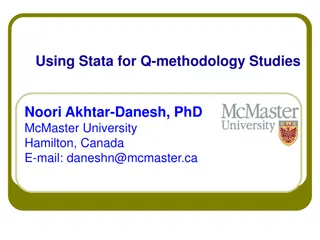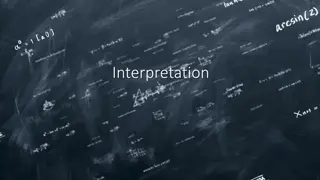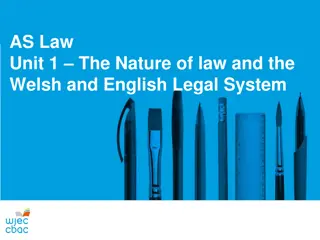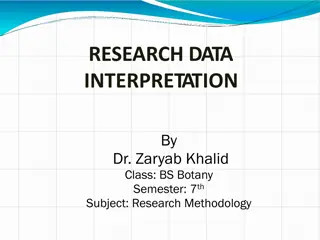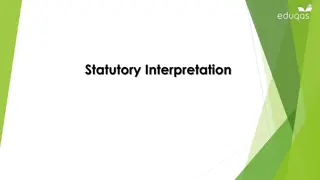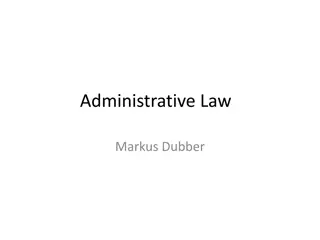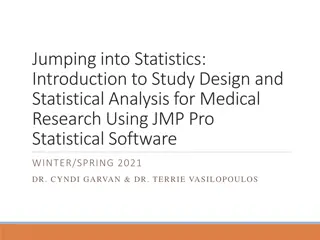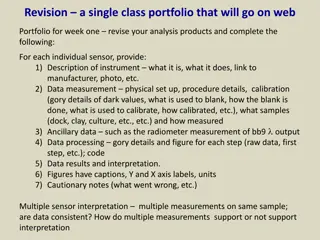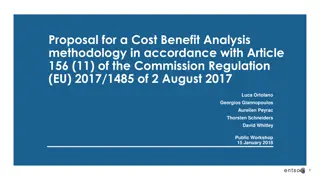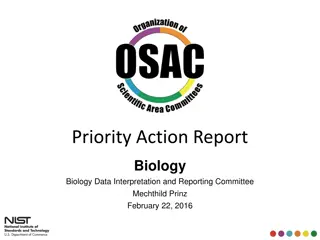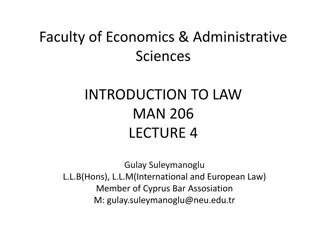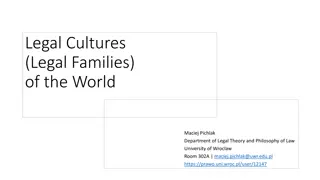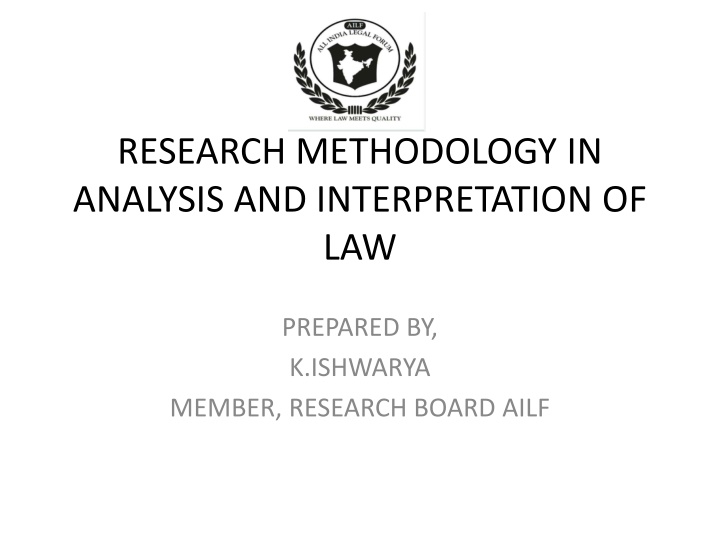
Research Methodology in the Interpretation of Law
Dive into the significance of researching statutes for law students, explore the interpretation of statutes, aids for interpretation, types of interpretation, and the difference between interpretation and construction in legal contexts. Gain insights into the methodology and analysis used in the interpretation of law.
Download Presentation

Please find below an Image/Link to download the presentation.
The content on the website is provided AS IS for your information and personal use only. It may not be sold, licensed, or shared on other websites without obtaining consent from the author. If you encounter any issues during the download, it is possible that the publisher has removed the file from their server.
You are allowed to download the files provided on this website for personal or commercial use, subject to the condition that they are used lawfully. All files are the property of their respective owners.
The content on the website is provided AS IS for your information and personal use only. It may not be sold, licensed, or shared on other websites without obtaining consent from the author.
E N D
Presentation Transcript
RESEARCH METHODOLOGY IN ANALYSIS AND INTERPRETATION OF LAW PREPARED BY, K.ISHWARYA MEMBER, RESEARCH BOARD AILF
INTRODUCTION The process of researching holds a very great significance in the growth of every student of law. Many perceive that the statutes does not need any research and a bare reading of legislatures would provide the complete meaning and fulfill the purpose of researching the legislature. But, the same has been proven wrong and the significance of researching how the Statutes needs to be interpreted grew significantly in the course of time when the judiciary was compelled to device laws of interpretation of laws based on the circumstances and cases before it. And the same shall be dealt hereinafter. AILF
INTERPRETATION OF STATUTES By interpretation or construction is meant, the process by which the courts seek to ascertain the meaning of the legislature through the medium of authoritative forms in which it is expressed." -Salmond The entire process of interpretation of statutes is based on the principle that all the statutes are, made with an intent and each and every statute has an intent. And in the course of time, the judiciary was expected to not just uphold the principles provided in the statutes but was also expected to uphold the intent with which it was made. This is the main reason that lead to the creation of rules as to how law has to be interpreted. The rule for application is to be selected based on the cases before the Court and the type of laws. AILF
AIDS FOR INTERPRETATION OF STATUTES INTERNAL AID Long title of the statute. Preamble of the statute. Chapter Headings of the statute. Marginal Notes to every section of statute. Punctuations. Illustrations given below the sections. Definitions. Provisos. Explanation. Saving Clauses and non-obstante Clauses. EXTERNAL AID Historical background. Statement of objects and reasons. The original Bill as drafted and introduced. Debates in the Legislature. State of things at the time a particular legislation was enacted. Judicial construction. Legal dictionaries. Commonsense. AILF
TYPES OF INTERPRETATION 1. THE INTERPRETATION 2. THE MISCHIEF RULE 3. THE GOLDEN RULE 4. HARMONIOUS CONSTRUCTION 5. LIBERAL CONSTRUCTION 6. EJUSDEM GENERIS LITERAL OR GRAMMATICAL
DIFFERENCE BETWEEN INTERPRETATION AND CONSTRUCTION CONSTRUCTION INTERPRETATION In law, interpretation refers to exposing the true sense of the provisions of the statutes and to understand the exact meaning of the words used in any text. Interpretation refers to the linguistic meaning of the legal text. In the case where the simple meaning of the text is to be adopted then the concept of interpretation is being referred to. Construction, on the other hand, refers to drawing conclusions from the written texts which are beyond the outright expression of the legal text. The purpose of construction is to determine the legal effect of words and the written text of the statute. In the case where the literal meaning of the legal text results in ambiguity then the concept of construction is adopted
LITERAL/GRAMMATICAL INTERPRETATION This is one of the basic rules of interpretation. According to the literal or grammatical rule of interpretation the provisions of a statute should be interpreted as such with their ordinary meaning. The basic rule is that whatever the intention legislature had while making any provision it has been expressed through words and thus, are to be interpreted according to the rules of grammar. Once after a given statute has been interpreted according to this rule, if the meaning complete and unambiguous then the statute can be considered applicable. This rule of interpretation stresses that the judiciary should interpret the law with its literal meaning, without adding or removing any kind of element to nature of that particular law whatever may be consequence of such interpretation maybe. This rule provides that the only obligation of the court is to expound the law as it is and if any harsh consequences arise then the remedy for it shall be sought and looked out by the legislature.
PRECEDENT In State of Kerala v. Mathai Verghese and Ors, 1987 AIR 33 SCR(1) 317 a person was caught along with the counterfeit currency dollars and he was charged under section 120B, 498A, 498C and 420 read with section 511 and 34 of Indian Penal Code for possessing counterfeit currency. The accused contended before the court that a charge under section 498A and 498B of Indian Penal Code can only be levied in the case of counterfeiting of Indian currency notes and not in the case of counterfeiting of foreign currency notes. The court held that the word currency notes or bank note cannot be prefixed. The person was held liable to be charge-sheeted.
MISCHIEF/HEYDONS RULE The origin of mischief rule can be traced back to Heydon s case where Lord Poke instrumented this rule. This rule basically tries to eliminate the previous mischief that was previously present in a law before its amendment where it seeks to reaffirm the intent behind the amendment. This rule involves 4 stages which are, 1. What was law before the Act was passed? 2. What was the mischief and defect for which the law had not provided? 3. What remedy Parliament has resolved and appointed to cure the disease? and 4. The true reason of the remedy and then the judges have to make such construction as shall suppress the mischief, and advance the remedy, and to suppress subtle inventions and evasions for continuance of the mischief.
PRECEDENT The accused in the case of Pyare Lal v. Ram Chandra, was prosecuted for selling the sweeten supari which was sweetened with the help of an artificial sweetener. He was prosecuted under the Food Adulteration Act. It was contended by Pyare Lal that supari is not a food item. The court held that the dictionary meaning is not always the correct meaning, thereby, the mischief rule must be applicable, and the interpretation which advances the remedy shall be taken into consideration. Therefore, the court held that the word food is consumable by mouth and orally. Thus, his prosecution was held to be valid.
THE GOLDEN RULE OF INTERPRETATION The golden rule of interpretation is one of the most significant rule in interpretation of laws. According to this rule, any law should be initially interpreted using literal rule of interpretation and if this stage results in any kind of ambiguity, injustice, inconvenience, hardship, inequity, then in all such events the literal meaning shall be discarded and interpretation shall be done in such a manner that the purpose of the legislation is fulfilled. This rule suggests that the consequences and effects of interpretation deserve a lot more important because they are the clues of the true meaning of the words used by the legislature and its intention. At times, while applying this rule, the interpretation done may entirely be opposite of the literal rule, but it shall be justified because of the golden rule.
PRECEDENT State of Punjab v.Quiser Jehan Begum,AIR 1963 SC 1604: A period of limitation was prescribed for, under section 18 of land acquisition act, 1844, that an appeal shall be filed for the announcement of the award within 6 months of the announcement of the compensation. Award was passed in the name of Quiser Jehan. It was intimated to her after the period of six months about this by her counsel. The appeal was filed beyond the period of six months. The appeal was rejected by the lower courts. It was held by the court that the period of six months shall be counted from the time when Quiser Jehan had the knowledge because the interpretation was leading to absurdity. The court by applying the golden rule allowed the appeal
DOCTRINE OF HARMONIOUS CONSTRUCTION when two or more provisions of the same statute are repugnant to each other, then in such a situation the court, if possible, will try to construe the provisions in such a manner as to give effect to both the provisions by maintaining harmony between the two.
PRECEDENT M.S.M Sharma v. Krishna Sinha, AIR 1959 SC 395 Facts of the case are as follows- Article 19(1)(a) of the Constitution provides for freedom of speech and expression. Article 19(3) provides to the Parliament for punishing for its contempt and it is known as the Parliamentary Privilege. In this case, an editor of a newspaper published the word -for- word record of the proceedings of the Parliament including those portions which were expunged from the record. He was called for the breach of parliamentary privilege. He contended that he had a fundamental right to speech and expression. It was held by the court that article 19(1)(a)itself talks about reasonable freedom and therefore freedom of speech and expression shall pertain only to those portions which have not been expunged on the record but not beyond that.
EJUSDEM GENERIS Halsbury s laws of England explains Ejusdem generis as follow, '"As a rule, where in a statute there are general words following particular and specific words, the general words must be confined to things of the same kind as those specified, although this, as a rule of construction;, must be applied with caution, and subject to the primary rule that statutes are to be construed in accordance with the intention of Parliament. For the ejusdem rule to apply, the specific words must constitute a category , class or genus; if they do constitute such a category, class or genus, then only things which belong to that category , class or genus fall within the general words "
CONCLUSION These rules of interpretation has proven to be of great significance since their very inception into the course of administration of justice. And these rules still prove to be great tools in delivering justice. All these rules are tools to ensure that justice is achieved though there may be some disparities in the plain reading in the provision of a statute. There are situations where more than one rule is used. Hence, all these laws are very important

